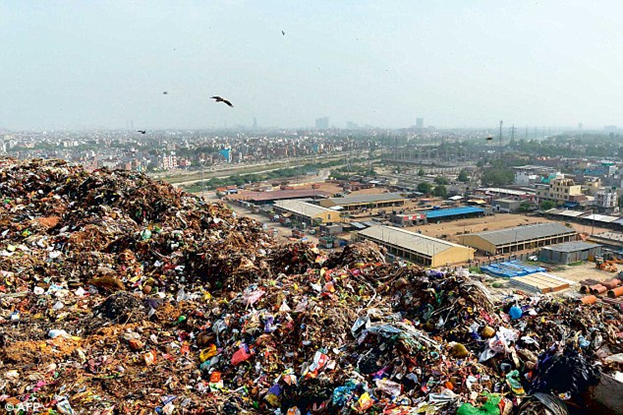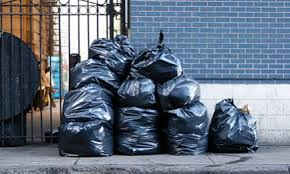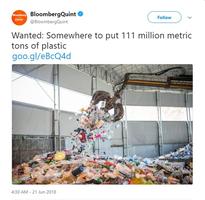Big billion day is back, so is the discussion on its effects on Green India and why its dragging down all the swachh bharat efforts into drain.
Waste Generation - Comparing New York City with Delhi
New York City generated 7.8 Million Tons of Municipal Waste
and spent $2.3 Billion ($1.8 Bn Tax payers, 400 Million Privately spent) to
collect from the curb and dispose it. (2012 data by CBS Survey).
Comparing it with Delhi with similar population density
(10756 (NY) vs 11297(Delhi) person per km) , which generates 3.05 Million Tons
of Municipal Waste(Delhi government MSW data) , allocated $344 Million for
sanitation (based on South Delhi municipal corporation press release of Rs.647
Crore for 2014-15, we assumed other two Delhi municipal corporations have a
similar budget).
These are two different examples from totally different cities, New York has all houses and building equipped with garbage collection mechanism to put trash on curbs for pickup, Delhi makes use of private contractors to collect trash, and a for a quick reference both look like below.
NYC Curbside garbage
Point here is not to compare a developed world City with a City from developing country. The point is cleaning, collecting and disposing off solid municipal waste anywhere, costs money and anything less than a stellar amount of money and technology can lead to disastrous consequences ranging from eye sores like above, to ground water contamination, pollution from inefficient incineration and landfills not maintained properly, looking like below.

Ghazipur Landfill(Source - News Reports in India).
I’m from NCR so this connects. But Bangalore, Mumbai or other folks can also relate with their own Ghazipurs.
It takes money to clean up this mess.
New York being the hub of consumerism gets cheap imports
from China and pays huge tax dollars to clean it. The waste ends up at
professionally managed landfills in far southern states with no real population
effected, there is a $75 billion industry behind it.
Delhi, also being aspirational and capital of India does get
its cheap share of imports from China along with domestic manufactures and as
per MCD generates 1/3rd of waste, spends 14% of what NYC spends out
of tax payer’s money and we can see these mounds all around.
With our growing consumer based economy, freeing up global imports, Make in India push, huge money getting into E- Retail (remember those discounts and billion dollar sales, companies running with 100s of Million dollars in red for years, electronics not working beyond a year – anecdotally) this mound is bound to grow, and would need a similarly huge mound of cash of tax payers money, to clean efficiently.
So India is not reduced to people living in between these
mounds of solid waste like sci-fi movie colonies.
What is the life cycle of waste and effects on Green India, Swachh Bharat?
Let’s use some basic economics to highlight the life cycle of waste.
- It’s manufactured in a factory harvesting raw materials, using electricity, generating air and water pollutants.
- In both India and China (remember USA only
designs) fossil is primarily burnt to generate electricity, this electricity is
subsidized and unreliable so factories also burn diesel (another subsidized
fuel), at least in India (Please check district profiles on BallotBoxIndia for
their industrial fuel usage).
- The laws governing industrial pollution are loose at best and implantation can’t be enforced due to weak regulatory framework, and to remain competitive (read cut cost) Industries in both these countries push out untreated waste in air and water bodies. (Ganga or Gomti didn’t get into this state by destiny or people bathing).
- This is transported to various destinations by trucks and locomotives, running on dilapidated and scant roads/railway infrastructure at uneven speed, idling on tolls/train traffic, again burning subsidized diesel on tax payer’s money.
This phone is again subsidized by
high competitive E-tail business selling first and refurbished models in the name of GMV (Gross merchandise value)
and sold to customers as a shiny example of aspiring India.
Then comes the usage cycle of the phone, no public data is
available on how long is the lifecycle of the product. But taking mobile phones
as example, we asked a small sample of youngsters in India and nobody uses a
phone more than a year and half, mostly they break or a cheaper better one is
available.
So the above cycle repeats every year, with the old phone in the
Ghazipur heap waiting for its turn.
Why this cycle is dangerous for Green India?
With so many forces pushing above cycle in the name of a certain GDP number, or growth parameter nudging people towards it. The sci-fi movie with people living between these mounds is not very far.
Especially for
cases like India where all the future cleanup cost would be borne by tax payers (Swachh Bharat Abhiyan) and keeping in view the thin tax revenue and efficiency track record of the sanitation
system in India the picture is not pretty.
- Supply and price of the supply are the key determinant.
Well, we live
in a free markets economy whose general composition depends on what is demanded
and what is demanded depends on supply and price of the supply, along with various
incentives, nudges and regulation for the market to go into certain direction.
- Why the product should be priced correctly?
So if a product is priced correctly with real expectations
set around it, people will demand a certain longevity from it, forcing
manufactures to think about quality controls, making less quantity but high quality
products. Customers will use them judiciously since now it’s a bigger part of
their portfolio. This will build an optimal product life-cycle.
So as broad strokes
1. Along with VAT or GST there should also be an
assessment of the sustainability cost or Green India Cost of the product, which should include
effluents produced (Air, Water), fuel burnt (fossil, renewable), transportation
green cost (average), disposal cost etc. and this should be added to the
product at each point before end customer.
2. There are close to 7300 economic activities (as per National Industrial Classification data) defined by Indian Government including services and manufacturing, it would be a good investment as a country to sample a few industries in each classification and quantify the green India cost per unit of production.
- Fossil fuel used for energy, and the cost
associated to nullify the effect of a permanent climate damage. If can’t be
nullified then effects expected should be quantified and advertised.
- The cost to clean up water tributaries and
purify the air (or effects of it), if the activity results in untreated
effluent discharge.
- What should be the lifetime expected(Manufacturer Warranty) before it’s
discarded for dump yard?
- The cleanup cost when it’s discarded by
prescribed methodology.
- The product longevity or warranty/guarantee should
be tied up with taxation system, manufacturers should tend to provide longer
guarantees to subscribe to lower taxes.
3. Higher quality controls on imports, we don’t want India to be a dumping yard of the western country used goods, or unregulated market of China’s surplus produce. If we have quantifiable Green Cost data from our internal production and sales activities it would be easy to put imports under the same lens. It will help with Swachh Bharat Abhiyaan too bringing down the costs and adding to the effectiveness of the whole process.
4. Force inbound imports to put these parameters on the label so
retailers and customers can have real expectation and environmental impact assessment from
the product. The duties levied should be based on the environmental impact of
the product life cycle on Indian Soil. Favorable, compliant and long living products
with larger warranties and repair promises would attract lesser duties, resulting in cheaper longer term pricing to customers.
5. Public awareness and customer protection
mechanism should be reformed around these quantifiable sustainability parameters.
Above are not huge pie in the sky kind of goals.
- The
assessments are already done in bits an pieces based on our existing industries
and dump-yards, Clean Ganga or related efforts and studies, all it needs is a
consolidation and augmentation to put them together as part of larger picture.
We at ballotboxIndia are determined to bring sustainable GDP to the forefront of policy debates, and would start multiple efforts under this to assess the Green cost of economic activities in India.
What can you as an Indian, who cares about your kids future do?
1. When these big billion day sales start, ask if you really need to buy this? or you are just swayed by advertising?
2. When these big billion day sales start, ask yourself, what should be ideal usage life of this product, I believe a phone should last at least 4 years, all my shoes are more than 6 years old, my gym bag is at least 10 year old (made in India). Remember how your moms used to repair and re-use.
3. Try buying from your local merchants, preferably made in your city, District, state or at least in India. May be visit a local cobbler, local tailor they are your countrymen, your neighbors, don't let them die out because you are falling prey to the easy life trick of a few investors sitting abroad making them super rich. As a fact people in countries like america find these local artisans a matter of luxury.
4. Always remember, even though you are paying a lower illusionary price right now for a lower quality product. Your government has already paid huge subsidy from your tax dollers, your health has already deteriorated due to environmental impact, your air and water systems have already been harmed and you will keep paying the cost for long and when the product gets decommissioned (i.e. you throw it out) again your government will "theoretically" clean India by spending tons of money. And when you pay for private schooling and healthcare, that's the cost you will keep paying to these Mega Billion Day Sale companies.
Join BallotboxIndia as a coordinator
Would you like to help with the research to support local and green economy in your community or state? Contact coordinators@ballotboxindia.com with your details.
Are coordinators funded?
Yes, we are working towards a massive change in our communities and how our economies work, what is the way to sustain India and its large population. Such efforts need community thought leaders and experts to come together and work in a cohesive and concerted way. The tools on this website are there to support a systematic way of working, but to keep the engagement long term incentives are definitely required. Write to coordinators@ballotboxindia.com with your details and start a conversation.
I would like to just follow the efforts right now.
Join this action group as a member by clicking the button "Join as Member" below to keep updated on as we go.
Why are we so worried? and would these companies every make any profits?
Since every E-Tailer in India is foreign investors owned here is our fear and Theory
Consider the scenario where Investor A who owns Indian E-Retailer, also owns stake in Chinese Manufacturing unit. Now say Chinese manufacturing unit sold an item which costed them Rs. 20 to the Indian arm at Rs. 100, so the Chinese arm made Rs. 80 in profit. Now the India arm sold the item at Rs. 70 giving 30% discount and booked loss in Indian system.
Now above has some very big implications.
- Foreign investors will always make profit.
- India will loose a lot of tax.
- Indian merchants and businesses will die out soon.
-India will end up with lots of garbage to maximize profits for Arm 1.
- Indian innovation will die out since these companies employ low skilled labors to minimize operating costs.
Again, GDPs, GVAs, GMVs etc are just numbers and if they don’t translate into general improvement of life in India with basics like clean air, water, healthy environment for growing our kids, they should be re-looked and rationalized.
Fairly priced GDP targets and calculations would help Green economic drivers to play a larger part, with population building wind turbines than cheap plastic or electronics consumer products, which are behind these billion dollar sales.
Keep an eye on this space for more.
Thanks
Ballot Box India Team.
 tag on profile.
tag on profile.








